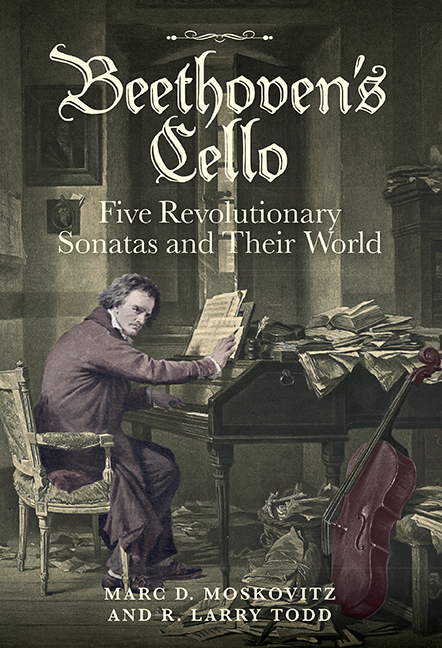Book contents
- Frontmatter
- Dedication
- Epigraph
- Contents
- Illustrations
- Foreword by Steven Isserlis
- Preface
- Personalia
- 1 From Bonn to Berlin
- 2 Music Fit for a King: The Sonata in F major Op. 5 No. 1 (1796)
- Interlude: Beethoven's Cellos
- 3 Tragic/Comic Masks: The Sonata in G minor Op. 5 No. 2 (1796)
- Interlude: Beethoven's Pianos
- 4 Themes and Variations
- Interlude: The Triple Concerto as Outlier
- 5 Friendship, War, Tears, and Grief: The Sonata in A major Op. 69 (1808)
- 6 Freedom and Control: The Sonata in C major Op. 102 No. 1 (1815)
- 7 ‘Most Remarkable and Strange’: The Sonata in D major Op. 102 No. 2 (1815)
- Interlude: Arranged Sonatas
- 8 Opus Posthumum
- Appendix 1 Primary Sources of Beethoven's Music for Cello and Piano
- Appendix 2 Reviews of Beethoven's Cello Music by His Contemporaries
- Notes
- Bibliography
- Index of Works by Beethoven
- General Index
Interlude: Beethoven's Cellos
Published online by Cambridge University Press: 18 April 2018
- Frontmatter
- Dedication
- Epigraph
- Contents
- Illustrations
- Foreword by Steven Isserlis
- Preface
- Personalia
- 1 From Bonn to Berlin
- 2 Music Fit for a King: The Sonata in F major Op. 5 No. 1 (1796)
- Interlude: Beethoven's Cellos
- 3 Tragic/Comic Masks: The Sonata in G minor Op. 5 No. 2 (1796)
- Interlude: Beethoven's Pianos
- 4 Themes and Variations
- Interlude: The Triple Concerto as Outlier
- 5 Friendship, War, Tears, and Grief: The Sonata in A major Op. 69 (1808)
- 6 Freedom and Control: The Sonata in C major Op. 102 No. 1 (1815)
- 7 ‘Most Remarkable and Strange’: The Sonata in D major Op. 102 No. 2 (1815)
- Interlude: Arranged Sonatas
- 8 Opus Posthumum
- Appendix 1 Primary Sources of Beethoven's Music for Cello and Piano
- Appendix 2 Reviews of Beethoven's Cello Music by His Contemporaries
- Notes
- Bibliography
- Index of Works by Beethoven
- General Index
Summary
THE STORY of Beethoven's cellos begins with a magnanimous gift from Prince Karl Lichnowsky, without whose support Beethoven's own story likely would have turned out very differently. That gift came in the form of a string quartet of valuable instruments given to the composer by the prince, in whose residence an ensemble assembled by violinist Ignaz Schuppanzigh held musical court. Though Schuppanzigh and his colleagues worked intimately with Beethoven on his early string quartets, the ensemble, which probably formed sometime around 1794, disbanded in 1799. According to Alois Fuchs, a former violinist in the imperial court orchestra, amateur musicologist, and autograph collector, around 1800 Schuppanzigh suggested to Lichnowsky that he give the set of string instruments to Beethoven - instruments that, we might reasonably assume, the prince had purchased and loaned out to the quartet members.
Beethoven's own words provide the earliest known reference to a string quartet of instruments in his possession: ‘I would like the instruments from Prince L[ichnowsky] to be preserved by one of you, but not to be the cause of strife between you, and as soon as they can serve you a better purpose, sell them.’ This passage comes from the Heiligenstadt Testament, the poignant document from 1802 that reads like a suicide note from Beethoven. As is well known, he preserved the document and mustered the strength to face down his deep depression and the deafness that threatened his life as a musician. Having come to terms with his irreversible hearing loss, Beethoven evidently never passed on ‘the instruments from Prince L’ to either of his brothers, the intended recipients of the document. On the contrary, a set of four instruments remained in the composer's possession until the time of his death. Then, with the disposition of his estate, confusion surrounding Beethoven's cello (and the other instruments) commenced in earnest. False labels and the suspected existence of a second cello were just two pieces of a riddle that consistently begged the question of whether what had come to be regarded as Beethoven's cello in fact was the instrument formerly owned by Lichnowsky and, subsequently, by the composer.
- Type
- Chapter
- Information
- Publisher: Boydell & BrewerPrint publication year: 2017

